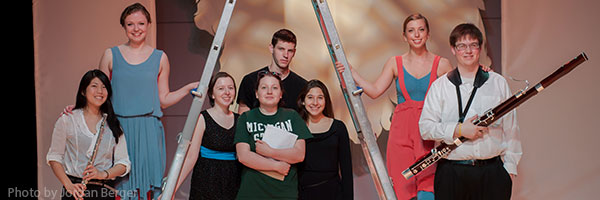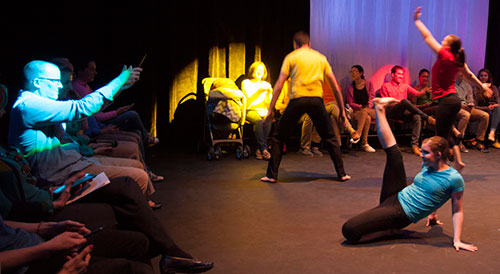

Theatre Engine: Dance Engine is a mash-up of live dance, electronic music, mobile phones and YOU. Theatre Engine begins as a game of words and ends as a dance party for all participants – with audience members interacting with movement artists and controlling lights and sounds. At its heart, Theatre Engine is about the simple joy of play, enhanced by cutting-edge technology. It is our pleasure to present you with a place where your actions and choices are an integral part of the performance – a unique theatrical experience, unlike anything you have seen before.
So stand up, jump in, and enjoy the show!
Theatre Engine has been performed at Michigan State University, St. Olaf College, Brigham Young University, ArtPrize, and the Edinburgh Fringe Festival. Click on the link to see that performance.
Description of Performance
 The audience sits in chairs arranged on all sides of the edge of the stage. The dancers enter the central stage space as the house lights dim. Each audience member has a tablet with the mobile application Theatre Engine downloaded. As the dancers begin to move, one audience member receives a short list of randomly chosen adjectives on their device. They select a word and the stage lighting, music, and dancers adapt their movements to align with the word chosen. For instance, if the word heroic is chosen the music will swell, the lights will increase intensity and the dancers will move heroically. If villainous is chosen, the music will turn sinister, the lighting will grow darker and the dancers will move with villainous intent. Example words include; staccato, lethargic, saucy…etc. The dance continues and a new audience member is given a new list of words. This section is called Adjectives.
The audience sits in chairs arranged on all sides of the edge of the stage. The dancers enter the central stage space as the house lights dim. Each audience member has a tablet with the mobile application Theatre Engine downloaded. As the dancers begin to move, one audience member receives a short list of randomly chosen adjectives on their device. They select a word and the stage lighting, music, and dancers adapt their movements to align with the word chosen. For instance, if the word heroic is chosen the music will swell, the lights will increase intensity and the dancers will move heroically. If villainous is chosen, the music will turn sinister, the lighting will grow darker and the dancers will move with villainous intent. Example words include; staccato, lethargic, saucy…etc. The dance continues and a new audience member is given a new list of words. This section is called Adjectives.
Call and Response, the next section brings the audience closer to movement control of the dancers. Five randomly chosen audience members have spots shine on them, with the color of each light corresponding to the color of the costume of one of the dancers. The audience member is prompted to move their device and the color-matched dancer expands on this movement, creating a cellphone duet.

Lights On/Off provides the audience a chance to explore the interplay between time, motion and space by allowing them to act as lighting designers. Five audience members are randomly chosen to have control over five distinct lights indicated by a lightswitch on their devices. If they switch it on, the light turns on. Conversely, if they switch off, the light turns off. When the lights are on, the dancers are frozen but when the light is off they move to new poses, switch places, or pick up odd props.

Drumcircle engages the audience communal music making. A light shines on first one audience member, then 2, then 4. Each person receives an image of a drum on their tablet and when tapped a drum sound is played over the speaker system. The dancers respond to the rhythm generated by the audience. At the end of the section, everyone can play a drum and the dancers dance in the cacophony.

Poses invites the audience to stand up and dance. All audience members receive text-based prompts on their devices such as “Pose Like A Ninja” or “Zombie.” Eventually, these instructions become less specific, and more inclined toward group activity (such as “Two-Person Airplane” or “Swarm”). The poses move from individual, to partner, to group and end with the entire audience moving and dancing through the space.

Photos by Jocelyn Bowman, Dean Neuburger, Todd F. Edwards, Deanna Christy
Videos by Emily Swenson and Alex Sanders,
Dancer Toss (2013), was presented in a typical performance setting where audience members remained seated. Live dancers performed a choreographed piece, then ran off and on stage in response to commands from audience cellphones. The audience then tossed an image of the dancers from phone to phone and then finally back to the stage. The results of this research were published in the International Journal of Pervasive Computing and Communications in a paper entitled Integrating the Audience Into a Theatre Performance Using Mobile Devices, which won second place for paper presentation at the International Conference on Advancements in Mobile Computing and Multimedia, Vienna, Austria, December 2013.
Click here to see video from "Dancer Toss."
Performance Dates: April 30th and May 2nd 2013
RCAH Theatre, Michigan State University
Photos by Jordan Berger, Steve VanMaele and Kelly Climer (http://www.kellyspictures.com)
Videos by Ryan Sundberg, Josh Rickert & Taylor Reschka